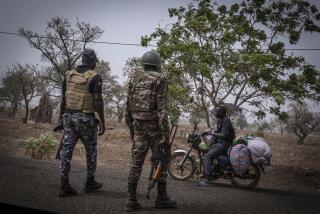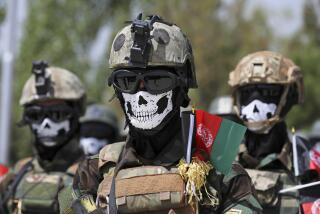War on West shifts back to Afghanistan
PARIS — The conflict in Iraq is drawing fewer foreign fighters as Muslim extremists aspiring to battle the West turn their attention back to the symbolically important and increasingly violent turf of Afghanistan, European and U.S. anti-terrorism officials say.
The shift of militants to Afghanistan this year suggests that Al Qaeda and its allies, armed with new tactics honed in Iraq, are coming full circle five years after U.S.-led forces ousted the Taliban mullahs.
Until Sept. 11, 2001, Afghanistan was the land of jihad: hallowed ground where fighters from across the Muslim world helped vanquish the Soviet Union in 1980s, fought alongside the Taliban in the 1990s and filled training camps overseen by Al Qaeda leader Osama bin Laden. Loss of the Afghan sanctuary scattered the networks and sent Bin Laden fleeing toward the Pakistani border region, where many anti-terrorism officials believe he remains.
After the fall of Iraqi President Saddam Hussein in 2003, Muslim extremists from the Arabian Peninsula, North Africa and Europe flocked to confront the U.S.-led coalition in Iraq. Although foreigners have been a minority in the Iraqi insurgency, militants such as Jordanian-born Abu Musab Zarqawi played a major role in suicide attacks and kidnap-killings.
But insurgent leaders in Iraq are now mainly interested in foreign recruits ready to die in suicide attacks, anti-terrorism officials say. Moreover, the conflict is dominated by violence between Sunni and Shiite Muslims. In contrast, an accelerating Afghan offensive by the resurgent Taliban offers a clearer battleground and a wealth of targets: U.S. and other North Atlantic Treaty Organization troops, and the Western-backed government.
As Iraqis have solidified control of their insurgency, the movement of foreign fighters to Iraq has “significantly declined in recent months,” said Pierre de Bousquet de Florian, director of the DST, France’s lead counter-terrorism agency.
“There is less need for them in Iraq, because there’s a need above all for kamikazes and there are not an infinite number of volunteers,” Bousquet, whose agency works closely with U.S., European and Arab counterparts, said in a recent interview. “The Iraqi insurgency is now very well organized around Iraqis.... Those who want to fight, but not necessarily to die as martyrs, go elsewhere.”
Simultaneously, Bousquet said, anti-terrorism agents have detected a new flow of militants heading to Afghanistan, where more than 1,000 French soldiers are among the approximately 40,000 foreign troops deployed.
Iraq attracted many Arabs, including Saudis, Yemenis and Syrians, Bousquet said. Algerians, Tunisians and other North Africans made up the second-largest group. About 100 fighters from Europe have gone to Iraq over a three-year period, he said.
“Today they return to the route of Afghanistan, or the tribal zones of Pakistan, where clearly they are thriving,” Bousquet said. “Certainly there are some Europeans, but very few. In contrast, in Afghanistan there are certainly many Pakistanis and people from Arab countries and some from North Africa.”
A leap in violence in Afghanistan this year has featured tactics such as suicide and roadside bombings that are trademarks of the insurgency in Iraq, according to Bousquet and other officials.
Despite decades of warfare, suicide bombings were rare in Afghanistan. But the number has shot up from six in 2004 to at least 78 so far this year.
“Clearly, methods have been transposed in Afghanistan that did not exist during previous wars in Afghanistan,” Bousquet said. “Like suicide attacks. And that’s directly influenced by what’s happening in the Middle East, in Iraq.”
Muslim extremists from North Africa make the odyssey to Afghanistan through routes that converge in Pakistan, another senior French anti-terrorism official said.
“There’s a new route along which [North Africans] pass through Peshawar and down into Afghanistan to carry out operations,” the senior anti-terrorism official said. “And what’s new is the suicide operations. That’s not at all part of the Afghan mentality.”
North Africans have been detected traveling to Koranic schools in Quetta and Peshawar, said Louis Caprioli, who retired as chief of the DST’s anti-terrorism division in 2004. The fighters use the schools as covers for their presence in Pakistan and as staging areas to cross into Taliban-dominated areas of Afghanistan, Caprioli said.
Foreign fighters are predominantly Sunni. They increasingly prefer fighting alongside the Taliban to getting embroiled in the Sunni-versus-Shiite bloodshed in Iraq, said Caprioli, who works closely with the intelligence community at the Paris-based GEOS security firm.
“There are a certain number of foreign jihadis who aren’t interested in massacring Shiites,” Caprioli said. “In Afghanistan, you have NATO troops to fight as well as Americans, all the ‘crusaders.’ ”
In addition, veterans of combat in Iraq have made their way to Afghanistan, officials said.
“There’s a definite increase in foreign fighters going to Afghanistan from all over,” said a U.S. anti-terrorism official, who spoke on condition of anonymity. “They go through Pakistan. Or they train in Iraq and then keep going to Afghanistan.”
U.S. Special Forces officers in Afghanistan learned last year that Arabs were being trained as suicide bombers in Iraq, then traveling through Iran to Pakistan, according to an intelligence document on a computer drive smuggled out of a U.S. base in Afghanistan and sold at a bazaar in April. Extremists transported the aspiring bombers, mostly Yemenis and Syrians, from Quetta across the border into Afghanistan, according to the document on the drive.
The U.S. anti-terrorism official said that militants from as far as away as the Caribbean island of Trinidad, which has a large number of residents of South Asian origin, had traveled to Afghanistan via South Africa.
Afghan officials blame foreigners for the escalating violence in their country. In several suicide bombings this year, witnesses and officials described attackers as Arabs.
“I think this is true that they are shifting Al Qaeda suicide attackers from Syria, and not only Syria but other countries like it, from other parts of the world, to Afghanistan through Iran and Pakistan and countries like that,” said Sayed Anwar, who recently served as deputy chief of the Afghan Interior Ministry’s counter-terrorism branch.
Basir Salangi, a police chief in eastern Nangarhar province, said Arabs, Chechens and Pakistanis conduct suicide and other attacks in the border regions, but that attacks in Kabul, the capital, are primarily carried out by Afghans who have been trained in Pakistan. And the combatants in Afghanistan still are overwhelmingly Afghans.
Afghan officials allege that key training centers for the Taliban are in Quetta, Peshawar and Miram Shah, and that militants use mountain routes to cross the border. “There are foreign fighters from several countries who have sanctuary and training in our neighboring country,” said Gen. Zahir Azemi, chief spokesman for the Afghan army, referring to Pakistan.
Pakistani officials deny such allegations. This year, Maj. Gen. Shaukat Sultan, a spokesman for the Pakistani military, said the “sweeping statement” that Pakistan harbored training camps for cross-border Taliban networks was “absurd.”
The movement of fighters to Iraq began to decline last year as insurgent leaders in Syria, who serve as a conduit to the combat zone, began screening volunteers aggressively, turning them back unless they had strong military skills or were eager to carry out suicide attacks, European anti-terrorism officials said.
Some newcomers were redirected to training camps in North Africa. Others were told to launch attacks in Europe, said a senior Italian anti-terrorism official. He described the confessions of Milan-based Tunisian and Moroccan suspects who got to Syria, but then were sent back: “They said the representative of Zarqawi’s group really grilled them: ‘Do you have military experience? Here’s an AK-47; do you know how to use it? Have you ever fired a mortar? If not, we don’t want you.’ ”
Instead, they were directed to bomb a basilica in Bologna because it displays a painting of the prophet Muhammad as depicted in Dante’s Inferno, investigators say. Moroccan and Italian police broke up the alleged plot and arrested the group this spring.
Meanwhile, Afghanistan’s historical allure for Islamic militants, the lawlessness of the Pakistani border region and the aggressiveness of the Taliban make for an ominous combination, anti-terrorism officials said.
Besides fighting in Afghanistan, Al Qaeda and its allies could once again use training venues and combat zones in the Afghan-Pakistani borderlands to groom terrorists for attacks in the West, Caprioli said. The suicide bombers who struck the London transport system last year and other British suspects in foiled terrorist plots traveled to Pakistan for training, expertise and direction, anti-terrorism officials say.
“Right now [extremists] go to Afghanistan to fight alongside the Taliban,” Caprioli said. “But the concern is that we could return to a situation like the one that existed before 2001, when they went for training and then came back. We have not reached that point yet. But people are beginning to get worried.”
Times staff writers Paul Watson and David Zucchino and special correspondent Wesal Zaman in Afghanistan contributed to this report.
More to Read
Sign up for Essential California
The most important California stories and recommendations in your inbox every morning.
You may occasionally receive promotional content from the Los Angeles Times.










